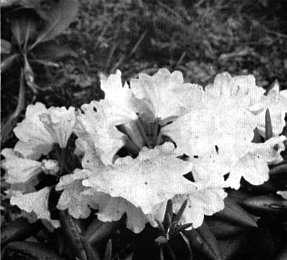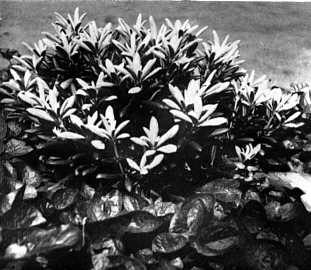QBARS - v12n4 An Outstanding Rhododendron
An Outstanding Rhododendron
By Maurice H. Sumner, San Francisco
If you could grow but a single rhododendron, which would it be? The question is a difficult one and the answer would necessarily be influenced by your personal preferences as to color, size of the shrub, growth habit and many other characteristics.
After viewing a great many rhododendrons this past Spring in English gardens, I find it fairly easy to select one above all others. That rhododendron is R. yakushimanum .
I saw it first a few years ago as a small plant blooming for the first time in an Oregon garden. Even though it had but one or two flower trusses, its unfolding pink buds and its deep green leaves marked it as an aristocrat among rhododendrons. I have seen it growing in a number of gardens since then, but the finest specimen was a three foot plant just breaking into bloom in the Royal Horticultural Society's gardens at Wisley, England.
My wife and I had been seeing literally thousands of magnificent rhododendrons in English gardens. Some were from seed collected by Hooker a hundred years ago and towered above us like oak trees. Others were as small as the rare R. lowndesii with its single yellow flower. But none were in the same class with R. yakushimanum .
We returned to Wisley three times solely to see the flowers on this plant develop from their dark pink buds to white bells flushed with pink. The flowers in each truss look upward as though proud of their beauty and were un-crowded and spaced at proper intervals over the whole shrub. This Wisley plant growing with other members of the R. ponticum series was some three feet tall and about as wide. Some of its neighbors were covered with larger flower trusses but none were as distinctive as R. yakushimanum . (Fig. 43) The plant with its (lark green elongated leaves folded around thick brown indumentum would be worth a high place in any garden if it never flowered. Its greatest glory, however appears when its rounded upright buds begin to swell and then open into a cluster of blush pink bells, not gaudy but subdued and dainty. Then it becomes the aristocrat of the rhododendron garden.
Will it become the parent of a fine new group of smaller rhododendrons? Opinion seems divided by those in the best position to know. An author in a recent book predicted that yakushimanum in the years ahead might well rival R. griersonianum in its popularity as a parent of a new race of hybrids. This prediction now appears doubtful. The best flowering group of these new hybrids that we saw were displayed by Wisley at the 1958 Chelsea Flower Show. R. yakushimanum x 'Borde Hill' was one of the best. The flowers varied on different seedlings from dark pink to white with an attractive pink stripe on the outside of some petals. R. yakushimanum x R. 'Pauline' produced another interesting plant with darker pink ruffled flowers. Crossed with R. 'Sir Frederick Moore' brought forth a light pink truss while the cross with R. dichroanthum showed the characteristics of R. dichroanthum and was the least attractive. All of these plants were about two feet tall and will probably retain a dwarf or semi-dwarf habit and many bloom five years from seed. With all of their beauty they do not any of them begin to equal their parent. None display the heavy brown indumentum nor the dark green rolled leaves which characterize R. yakushimanum . (Fig. 44)

|

|
|
Fig. 43.
R. yakushimanum
Cecil Smith photo |
Fig. 44
R. yakushimanum
showing its
fine habit and spectacular new growth. Cecil Smith photo |
Windsor Great Park are also growing an attractive group of these crosses including R. yakushimanum crossed with R. wardii , 'Loderi', R. souliei , and 'Hawk'. We saw these plants just as the buds were about to break so can only report that they are attractive in growth habit and set flower buds generously while still small plants.
It will probably be some twenty years before these plants can be propagated in sufficient quantity to be commercially available and then only in limited numbers. Accordingly more progress in the United States may be expected from crosses already made or being made here. One difficulty has been to obtain the true form of R. yakushimanum . We were told in Wisley that blossoms hand pollinated with pollen from the same plant produced very little seed and in many cases no seed. I received seed from Wisley in 1953 and am now growing twenty-nine seedlings. Eleven of these appear to be the true R. yakushimanum judging by their typical foliage and indumentum. The other eighteen seedlings are completely different indicating that the bees have been at work and that this rhododendron will accept pollen from other rhododendrons.
Some rhododendrons earn a place in a garden solely by the immensity of their blooms or the intensity of the color of their flowers. Not so with R. yakushimanum . The delicate tints of its flowers held so proudly are those to stir a poet's heart or inspire an artist's hand. It is truly an outstanding rhododendron.
